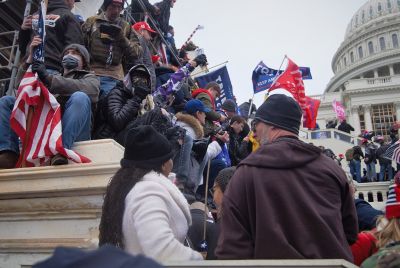Isis fighters flee western Mosul by boat leaving streets littered with bodies and blood
Iraqi soldiers in eastern Mosul have celebrated victory by pausing for selfies with Daesh corpses.

On a flyblown street in eastern Mosul on Tuesday, the evidence of the final panicked moments of Islamic State control of the Andalus district lay strewn among congealing pools of blood. Around a metre deep crater in the centre of the pavement, six dead IS fighters lay in heaps of tangled limbs and scorched flesh like macabre marionettes.
"They were running scared," a man standing outside his house said of the insurgents' final moments before they were killed by a coalition airstrike the day before.
The largest urban battle since World War Two (as the UN humanitarian coordinator for Iraq has described Mosul) is at a turning point. After holding out for three months against a vastly superior force of Iraqi Security Forces, the last IS defences in east Mosul crumbled this week. But while some districts were abandoned in disarray, other IS fighters made more strategic withdrawals to the west, suggesting that the coming battle there could be even bloodier.
Andalus – an upper middle class district of tidy homes with lush gardens – was one of the last eastern neighbourhoods occupied by IS. On Tuesday though small children ran among the corpses in the street, excited to leave the house for the first time in weeks and by the presence of the burly black-uniformed Iraqi Special Operations Forces soldiers who tussled their hair and handed out Iraqi flags.
Melting into the pavement, one of the bodies looked scarcely older than the skipping children. His small charred corpse – naked except for where someone had dropped a hat over his prepubescent groin – had fused to his AK-47 assault rifle as he burned. A neighbour who had peered out the window at the fighters estimated he might have been 15 at most.
For months, ISOF soldiers have insisted that the fighters they face in Mosul are not of the same calibre as the professionally trained jihadis they battled earlier in Baiji, Tikrit and Anbar province. A recent IS propaganda video also offers clues the group might be running low on fighters. The clip – shared by analyst Charlie Winter and claimed to have been filmed in Mosul recently – shows men and young boys signing up to join the ranks of IS in defending the city.
One IS tactic that requires scant instruction though is suicide attack. The ISOF soldiers advancing in Andalus faced four suicide car bombs on Monday. The international coalition claims though that these vehicle bombs now are much less effective than in the past – plated with less armour and packed with less explosives. Of the four on Monday, only one managed to detonate near an ISF target.
Ahmed Mahmoud stood outside his home looking at the bodies outside his gate. "They were panicking," the 40-year-old civil engineer said of the six fighters' last moments. "They were clearly not familiar with this neighbourhood because they didn't know where they were. They were all running in different directions. They tried to get in our house but we had locked the door."

The fighters were likely frantic and paranoid from being shut inside for months hiding from coalition surveillance aircraft, a nearby neighbour believed. Several streets away, Mohamed Yessem Yehyia had lived across the street from a house occupied by IS fighters. The fighters had hung sheets across the yard to block the view of their house. "They didn't let us use the upstairs of our house because it looked out on their yard," said Yehyia, a 30-year-old former government worker. "We weren't even allowed to look at them when we went out in the street."
As the soldiers took selfies with the corpses a man asked when they would be removed.
Mahmoud, the civil engineer, was looking out at the fleeing fighters from behind the curtains when a coalition bomb detonated in the street, a scant 30 metres from where he was watching. The explosion blew out all the windows in the street, and Mahmoud was lightly wounded by the flying glass and debris.
Next door though his immediate neighbour's house fared worse, being blown open and then catching fire. Fortunately they weren't home, Mahmoud said, though four other neighbours were injured.
A huge cloud of dust rose, leaves rained down from the trees, and the fighters died unceremoniously. One defecated as he expired, another never had the chance to detonate the suicide belt he was wearing. The neighbours left them where the fell – only one was offered the dignity of being covered with a blanket. A piece of twisted sheet metal covered another.
As the soldiers took selfies with the corpses a man asked when they would be removed. "There are children here," the man said, before making a half-hearted attempt to shoo them inside a yard, where their heads peered out from around the gate.
"Our job is pretty much done on this side," the soldiers' commander Lieutenant General Abdul-Wahab al-Saadi said later that day. The next day, the Iraqi military announced the total liberation of east Mosul.
Meanwhile though, the coalition was watching significant movement of IS fighters and material to the west. The Tigris River runs through Mosul, dividing the city in two. With coalition airstrikes already having taken out the bridges, IS fighters were crossing on boats. On Wednesday, the coalition reported that airstrikes "destroyed 49 watercraft" as the fighters withdrew. It did not say how many made it safely across.
After three months of painstaking progress in house to house fighting, the final speed with which IS defences crumbled suggest that they may have made a strategic withdrawal to more defensible terrain in the west of the city. The ISF are now expected to regroup before eventually crossing the Tigris on pontoon bridges. Then they will have to fight for the old neighbourhoods of Mosul –densely populated warrens of streets too narrow for their armoured vehicles.
"We cannot say what comes next on the west side," commander al-Saadi said as he pondered the coming battle.
© Copyright IBTimes 2025. All rights reserved.





















